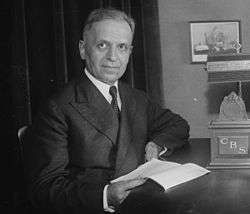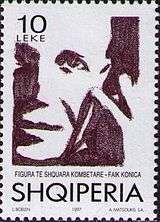Faik Konica
| Faik Konica | |
|---|---|
 | |
| Born |
March 15, 1875 Konitsa, Janina Vilayet, Ottoman Empire |
| Died | December 15, 1942 (aged 67) |
| Other names | Dominic |
| Alma mater | Harvard |
| Occupation | Writer, statesman |
| Known for |
Albanian language literary style Albania periodical Dielli periodical Vatra Federation Albanian Congress of Trieste First Albanian Ambassador to United States |
Faik Konica (March 15, 1875 – December 15, 1942), born in Konitsa,[1] was one of the greatest figures of Albanian culture in the early decades of the twentieth century. Prewar Albanian minister to Washington, his literary review, Albania, became the focal publication of Albanian writers living abroad. Faik Konica wrote little in the way of literature, but as a stylist, critic, publicist and political figure he had a tremendous impact on Albanian writing and on Albanian culture at the time.
Biography
Konica was born on March 15, 1875 in the town of Konitsa,[1] Janina Vilayet, Ottoman Empire, now in northern Greece, not far from the present Albanian border. After elementary schooling in Turkish in his native village, he studied at the Xavierian Shkodër Jesuit College in Shkodra which offered him not only some instruction in Albania but also an initial contact with central European culture and Western ideas. From there, he continued his schooling at the eminent French-language Imperial Galatasaray High School in Istanbul.
In 1890, at the age of fifteen, he was sent to study in France where he spent the next seven years. After initial education at secondary schools in Lisieux (1890) and Carcassonne (1892), he registered at the University of Dijon, from which he graduated in 1895 in Romance languages and philology. After graduation, he moved to Paris for two years where he studied Medieval French literature, Latin and Greek at the famous Collège de France. He finished his studies at the prestigious Harvard University in the United States, although little is known of this period of his life. As a result of his highly varied educational background, he was able to speak and write Albanian, Greek, Italian, French, German, English and Turkish fluently. In 1895 Konica converts to Roman Catholic, and changes his name from Faik to Dominik, signing for many years as Faik Dominik Konica.[2] However, in 1897 he would say "All religions make me vomit" [3]
Konica strove for a more refined Western culture in Albania, but he also valued his country's traditions. He was, for instance, one of the first to propagate the idea of editing the texts of older Albanian literature. In an article entitled "Për themelimin e një gjuhës letrarishte shqip", (On the foundation of an Albanian literary language), published in the first issue of Albania, Konica also pointed to the necessity of creating a unified literary language. He suggested the most obvious solution, that the two main dialects, Tosk and Gheg, should be fused and blended gradually. His own fluid style was highly influential in the refinement of southern Albanian Tosk prose writing, which decades later was to form the basis of the modern Albanian literary language (standard language).
Albania (periodical)

While in Brussels, in 1896–7 Konica started the publication of the periodical Albania, which ended its publications in 1909. It was printed both in Brussels and Paris. The magazine was one of the most important rilindas magazines of that time.[4]
In 1903–1904, Faik Konica was resident at Oakley Crescent in Islington, London. There he continued to edit and publish, under the pseudonym Thrank Spirobeg, the dual language (French/Albanian) periodical Albania that he had founded in Brussels in 1897. He contributed bitingly sarcastic articles on what he saw as the cultural backwardness and naivety of his compatriots.
Albania helped to spread awareness of Albanian culture and the Albanian cause across Europe, and was highly influential in the development and refinement of Southern Albanian prose writing. In the words of the famous French poet Guillaume Apollinaire, "Konica turned a rough idiom of sailors inns into a beautiful, rich and supple language". Theodor Anton Ippen, a diplomat of Austria-Hungary, was one of the authors whose texts were published in the Konica's periodical.[5] Konica assured Ippen that he and his friends believed that Albania should be in political and military union with Austria.[6]
Whilst in Brussels, Konica had a correspondence with Apollinaire regarding an article published by the poet in L'Europen. When Apollinaire came to London seeking to regain the affections of Annie Playden, an English governess he had met and fallen in love with in Germany, he stayed with Konica at Oakley Crescent.
Apollinaire published a memoir of Konica in the Mercure de France on May 1, 1912, which begins: "Of the people I have met and whom I remember with the greatest pleasure, Faik Bey Konica is one of the most unusual". He recalls:
We would have lunch the Albanian way, which is to say, endlessly. The lunches were so long that I could not visit a single museum in London, as we would always arrive when the doors closed, and the attention and care with which Konica edited his articles meant that the journal always came out very late. In 1904, only the issues for 1902 appeared; in 1907, the issues for 1904 came out at regular intervals. The French journal L'Occident is the only one that could compete with Albania in that respect.
Political activities and death
Konica organized the Albanian Congress of Trieste, held February 27 – March 6, 1913.[7]

Konica went to Boston, US in autumn of 1909 where he took over as chief-editor of Dielli newspaper, published by Besa-Besën society, an political-cultural organization of Albanian-American diaspora. With the creation of Vatra, the Pan-Albanian Federation of America, his role inside the Albanian community of US grew and he became general-secretary if Vatra. Konica was a close collaborator of Fan Noli and one of the main figures in Vatra's and Dielli's history. In 1911, he published Trumbeta e Krujes (Kruja's trumpet), a very short lived newspaper in St. Louis, MO.
He got disappointed with the Austro-Hungarian authorities and Ismail Qemali personally, after Qemali's approval for the creation of an Austro-Italian bank (though named Bank of Albania - Albanian: Banka e Shqiperise), which was feared amongst Albanians as having been created for massive purchasing of land properties and controlling the future economy of Albania.[8] Konica was one of the main organizers of the Albanian Congress of Trieste in 1913.[9] On November 20, 1913 he went in conflict with Essad Pasha and left Durres together with his collaborator Fazil Pasha Toptani.[10]
In 1921, he went back to the US where he became president of Vatra, and a columnist in Dielli. In 1929, Ahmet Zogu - newly proclaimed King Zog I of Albania would appoint him as Albanian Ambassador to the United States despite his very low opinion on Zogu.[11] He carried this duty until 1939 when Fascist Italy invaded Albania.[12] Konica was a harsh criticizer of King Zog's decision to abandon Albania on the eve of the Italian invasion.[13]
He died in Washington on December 15, 1942 and was buried in Forest Hills Cemetery in Boston. In 1998 his remains were transferred to Tirana and interred at the Tirana Park on the Artificial Lake.[14]
References
- 1 2 Mann, Stuard Edward (1955). Albanian literature: an outline of prose, poetry, and drama. p. 99.
- ↑ Thanas L. Gjika, "Konica hapi epokën e rikrishterizimit të shqiptarëve"
- ↑ http://www.gazeta-shqip.com/lajme/2014/09/11/myslimanet-shqiptare-ne-anen-e-gabuar-te-historise/
- ↑ The Albanians: an ethnic history from prehistoric times to the present By Edwin E. Jacques page 299
- ↑ "Qui était Faik Konica?". http://www.konitza.eu. 2009. Retrieved January 1, 2013.
Les collaborateurs et le contenu de la revue "Albania". La collection d'Albania est réunie en 12 volumes qui font 2500 pages. Ses collaborateurs étaient des écrivains et intellectuels réputés de son temps en Europe comme Guillaume Apollinaire, Emile Legrand, Jan Urban Jarnik, Holger Pedersen, Albert Thumb, Théodore Ippen, etc.
External link in|publisher=(help) - ↑ Tarifa, Fatos (1985). Drejt pavarësisë: çështja e çlirimit kombëtar në mendimin politik-shoqëror rilindës 1900–1912 (in Albanian). Tirana: Shtëpia Botuese "8 Nëntori". p. 102.
Është opinioni im dhe i miqve të mi" i shkruante Konica më 1897 konsullit austriak në Shkodër Teodor Ippen – se "do të ishte fat nëse Shqipëria do të arrinte të gëzojë një autonomi administrative me një bashkim politik dhe ushtarak me Austrinë
- ↑ Elsie, Robert. "Albanian Voices, 1962 – Fan Noli". Robert Elsie's personal website. Archived from the original on January 21, 2011. Retrieved January 21, 2011.
Congress of Trieste which was organized by his friend and rival Faik bey Konitza
- ↑ Fan Noli, Kostandin Chekrezi (1918), Kalendari i Vatrës i motit 1918, Boston: Vatra Press, p. 29
- ↑ Elsie, Robert. "Albanian Voices, 1962 – Fan Noli". Robert Elsie's personal website. Archived from the original on 21 January 2011. Retrieved 21 January 2011.
Congress of Trieste which was organized by his friend and rival Faik bey Konitza
- ↑ Fan Noli, Kostandin Chekrezi (1918), Kalendari i Vatrës i motit 1918, Boston: Vatra Press, p. 30
- ↑ Nasho Jorgaqi, Xhevat Lloshi, ed. (1993), Faik Konica - Vepra (1 ed.), Tirana: Shtepia Botuese "Naim Frasheri", p. 506, OCLC 49987449,
...tell your King that as right as my critics are towards his regime, I will restrict them inside the Albanian circles, meanwhile outside of them I will defend the regime with all I can. I will continue to serve the King with loyalty and without arguing, because I am his representative and because he is the Head of the Albanian State. But on a personal level, I feel the maximal contempt towards him
- ↑ Elsie, Robert (January 2006). Albanian literature: a short history. I. B.Tauris & Company, Limited. p. 106. ISBN 1-84511-031-5.
had initially given his support to the government of Essad Pasha Toptani
- ↑ Nasho Jorgaqi, Xhevat Lloshi, ed. (1993), Faik Konica - Vepra (1 ed.), Tirana: Shtepia Botuese "Naim Frasheri", p. 511, OCLC 49987449
- ↑ Gottschling, Anila. "What to visit in Tirana" (in Albanian). Retrieved July 26, 2010.
External links
| Wikimedia Commons has media related to Faik Konica. |
- Robert Elsie's introduction to Faik Konitza (pdf)
- "Faïk Konitza – Selected Correspondence 1896–1942"
- "Albanian Articles of Faik Konica at shqiperia.com"
- Luan Starova: "Faik Konitza and Guillaume Apollinaire"
- "Sister Act". Time Magazine. March 28, 1938. Retrieved 2008-08-10.
- Faik Konica, Vepra 1, 2, 3, 4 on shtepiaelibrit.com
- "Albania" – by Faik Konitza (Jun 1898 – Nov 1899)
Further reading
- Faik Konica; Bejtullah D. Destani (2000). Faik Konitza: Selected Correspondence. Centre for Albanian Studies. ISBN 978-1-873928-18-9. Retrieved May 9, 2013.